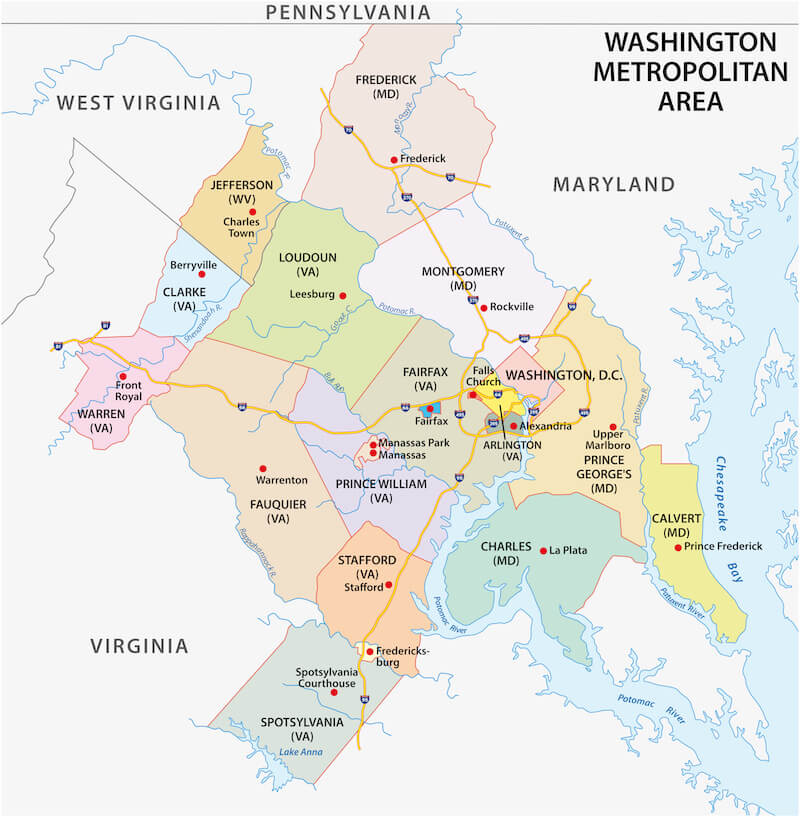

Considering a Move to the Washington D.C., Arlington, Alexandria Metro Area? Here’s What You Should Know
Moving to the Washington–Arlington–Alexandria Metro? Here's How It’s Laid Out
Commonly called the DC Metro, this region spans parts of DC, Northern Virginia, and suburban Maryland, with over 6.3 million residents. It’s one of the most educated, diverse, and high-income metros in the U.S., with a deep bench of government, tech, international, and nonprofit jobs.
This is a metro that runs on policy, global affairs, contracts, and credentials—but also one with walkable neighborhoods, green space, and cultural clout. From rowhouses in DC to sleek condos in Arlington and leafy subdivisions in Bethesda or Fairfax, it offers urban energy and suburban comfort within the same region.
Economy & Cultural Landscape of the DC Metro
The DC region is recession-resistant and incredibly career-diverse:
The federal government is still the largest employer, but the metro also boasts booming sectors in tech (especially in Northern Virginia), defense, consulting, law, and international NGOs. Amazon’s HQ2 in National Landing (Arlington) has fueled new growth in tech and infrastructure. DC is also home to world-class universities, healthcare systems, and think tanks.
Culturally, the area offers a blend of global sophistication and hyper-local charm: Access to the Smithsonian, National Mall, performing arts, and embassies gives DC global weight.
Arlington, Alexandria, and Bethesda offer micro-neighborhood culture, food scenes, and great transit. Outdoor lovers appreciate how walkable and park-filled this urban metro can be, plus trails like the Capital Crescent and Mount Vernon paths.
The DC Metro Structure
The metro orbits around the District itself and follows major transit lines and highways. It’s best understood in these zones:
- District of Columbia (NW, NE, SW, SE) – Core of city life with distinct quadrants and neighborhoods.
- Northern Virginia (Arlington, Alexandria, Fairfax, Falls Church) – Dense suburbs with strong transit, schools, and job hubs.
- Maryland Suburbs (Bethesda, Silver Spring, Takoma Park, Rockville, Gaithersburg) – Highly educated, family-friendly, and culturally rich.
- Outer Suburbs & Exurbs (Loudoun, Prince William, Howard, Anne Arundel Counties) – More space, more house, longer commute.
Most residents define their lifestyle in relation to the Metro rail system, commuting patterns, and access to federal and regional employers.
The Main Areas of the Washington D.C. Metro
District of Columbia (NW, NE, SW, SE)
The Vibe: Walkable, historic, and diverse. A city of neighborhoods, parks, rowhouses, embassies, bike lanes, brunch lines, and policy talk.
Why It Works: Endless culture, transit coverage, access to jobs, and social/professional energy. You can walk or bike to everything.
Watch Out For: High housing costs, neighborhood-by-neighborhood differences in safety and schools, tight space.
Good Fit For:
- Young professionals
- Government staffers
- Grad students
- Remote workers
- People who want culture on their doorstep.
Check out LookyLOO's Deep Dive into Washington D.C. to better understand whether this area is right for you.
Northern Virginia
Includes: Arlington, Alexandria, Falls Church, Fairfax
The Vibe: Dense, polished, transit-connected suburbs with strong schools, condos, and family neighborhoods—plus a ton of jobs.
Why It Works: Metro access, close to DC and the Pentagon, excellent public schools, and major job growth (Amazon HQ2, defense/tech).
Watch Out For: Expensive housing in Arlington/Alexandria, traffic congestion, and rapid development reshaping some neighborhoods.
Good Fit For:
- Families
- Tech workers
- Military/government professionals
- Buyers wanting a quieter life with urban access.
Check out LookyLOO's Deep Dive into Living in Northern Virginia (Arlington, Alexandria, Falls Church, Fairfax) to better understand whether this area is right for you.
Maryland Suburbs
Includes: Bethesda, Silver Spring, Takoma Park, Rockville, Gaithersburg
The Vibe: Suburban with brains, charm, and diversity. Walkable town centers, leafy streets, and a mix of tradition and progressivism.
Why It Works: Strong public schools, Metro Red Line access, more space than DC, with many of the same perks.
Watch Out For: Prices still high in popular areas; some neighborhoods are car-dependent despite their reputation.
Good Fit For:
- Families
- Healthcare/research professionals
- Federal employees
- Anyone seeking a city-suburb hybrid lifestyle.
Check out LookyLOO's Deep Dive into Maryland Suburbs (Bethesda, Silver Spring, Takoma Park, Rockville, Gaithersburg) to better understand whether this area is right for you.
Outer Suburbs & Exurbs
Includes: Loudoun, Prince William, Howard, Anne Arundel Counties
The Vibe: Spacious, suburban, and more affordable. Further out from the core, but with good schools, trails, and new homes.
Why It Works: More house for the money, great for remote workers or dual-income families, and good school districts.
Watch Out For: Longer commutes, limited walkability, and less cultural access than the inner ring.
Good Fit For:
- Families needing space
- Hybrid workers
- Buyers priced out of closer-in suburbs
- People craving quiet.
Check out LookyLOO's Deep Dive into Washington D.C.'s Outer Suburbs & Exurbs to better understand whether this area is right for you.
TL;DR – How to Choose Where to Live in the DC Metro
Subregion-----------------------------------Best For
District of Columbia---------------------------Young professionals, policy folks, creatives, urban lovers
Northern Virginia-----------------------------Families, tech/gov pros, Amazon HQ2 employees, urban-suburban balance seekers
Maryland Suburbs----------------------------Families, federal workers, great schools, walkable suburbs, diversity
Outer Suburbs & Exurbs----------------------Remote/hybrid workers, growing families, affordability-minded
Final Thoughts: Where to Focus Your Search in the DC Metro
If you want walkability, culture, and nonstop city energy, the District itself gives you access to everything from row houses near Eastern Market to condos in Navy Yard to stately homes in Northwest. If you’re looking for great schools, career access, and transit-friendly suburbs, Northern Virginia blends city proximity with top-tier livability, especially in Arlington and Alexandria.
Prefer something a bit more chill but still walkable and family-friendly? The Maryland suburbs like Bethesda and Silver Spring offer charming downtowns, diversity, and direct Metro access. And if your priorities are space, savings, and schools (and you don’t mind a longer drive or train ride), the outer counties in Maryland and Virginia deliver breathing room while still keeping DC in reach.
